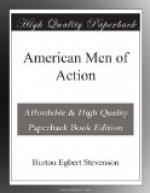They were born a year apart. Burr in 1756, at Newark, New Jersey; Hamilton, in 1757, on the little West Indian island of Nevis. Burr was of a distinguished ancestry, his grandfather being the famous Jonathan Edwards; Hamilton’s father was an obscure planter whose first name has been lost to history. Burr graduated at Princeton, entered the army, rose to the rank of lieutenant-colonel, and resigned in 1777 to study law, being admitted to the New York bar five years later. Hamilton was sent to New York, entered King’s, now Columbia, College, got caught in the rising tide of Revolution, proved himself uncommonly ready with tongue and pen, enlisted, saw the battles of Long Island, Trenton, and Princeton, was appointed aide-de-camp to Washington and acted as his secretary, filling the post admirably, but resigned in a fit of pique over a fancied slight, and repaired to New York to study law. Such, in outline, is the history of these two men until Fate threw them in each other’s way.
New York City was the arena where the battle was fought. Within a few years, Hamilton and Burr were the most famous men in the town. They resembled each other strongly in temperament and disposition; each was “passionate, brooking no rivalry; ambitious, faltering at no obstacle; proud with a fiery and aggressive pride; eloquent with the quick wit, the natural vivacity, and the lofty certainty of the true orator.” They were too nearly alike to be friends; they became instinctive enemies. Each felt that the other was in the way.
For sixteen years, Burr practiced law in New York, growing steadily in influence. For five of those years, Hamilton did the same. They were the foremost lawyers in the city. No man could stand before them, and when they met on opposite sides of a case, it was, indeed, a meeting of giants. But in 1789, Washington appointed Hamilton his secretary of the treasury, and leaving New York, Hamilton applied himself to the great task of establishing the public credit, laying the basis for the financial system of the nation, which endures until this day. It was a splendid task, splendidly performed, and Hamilton emerged from it the leader of the powerful Federal party.
In 1800, two men were candidates for the presidency. One was Thomas Jefferson and the other was Aaron Burr. Instead of being overwhelmed by the great Virginian, Burr received an equal number of electoral votes, and the contest was referred to Congress for decision. As a Federalist, Burr felt that he should have Hamilton’s support, but Hamilton used his great influence against him, stigmatizing him as “a dangerous man,” and Jefferson was elected. Four years later, Burr was a candidate for governor of New York, and again Hamilton openly, bitterly, and successfully opposed him, again speaking of him as “a dangerous man.”




